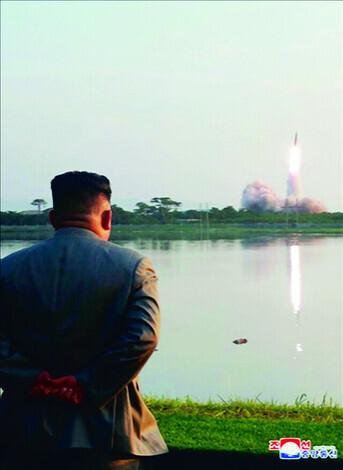hankyoreh
Links to other country sites 다른 나라 사이트 링크
N. Korean ballistic missiles fired last month traveled farther than reported, defense minister says

South Korean Defense Minister Suh Wook said that North Korean ballistic missiles launched on March 25 were believed to have traveled for 600 kilometers (km). The Joint Chiefs of Staff had earlier said that the missiles flew for about 450km.
“It’s difficult for our detection assets to spot a missile launched toward the East Sea from below because of the curvature of the earth. Since the missile used a pull-up maneuver, it’s presumed to have flown for 600km, which is longer than expected,” Suh told members of the National Assembly’s National Defense Committee on Wednesday.
Suh had been asked by People Power Party lawmaker Yun Ju-keyng about the South Korean military’s ability to track the short-range ballistic missiles fired by North Korea on March 25.
A pull-up maneuver is a type of irregular movement that North Korea said it developed for its KN-23 guided missile, also known as a North Korean version of the Iskander. During its descent phase, the missile is believed to level out and then climb sharply to avoid interception by South Korean or American missiles.
Soon after the missile launch on March 25, South Korea’s Joint Chiefs of Staff notified reporters that the military had detected two short-range missiles launched from the area of Hamju, South Hamgyong Province, into the East Sea at 7:06 and 7:25 am. The Joint Chiefs further said that the missiles had traveled about 450km with an altitude of about 60km and that South Korean and American intelligence agencies were analyzing the details.
Japan’s Ministry of Defense also announced that North Korea had fired two ballistic missiles to the east. Japan estimated that the missiles had each flown for 450km at an altitude lower than the trajectory of the Scud, another short-range ballistic missile in North Korea’s arsenal.
But the next day, North Korea’s state-run Korean Central News Agency (KCNA) announced that the missiles represented an upgraded weapon system that augmented previously developed guided missile technology with a 2.5-ton warhead. The KCNA also said that the two guided missiles had precisely struck their designated targets at 600km in the East Sea.
Suh declined to provide any more details about how he’d come to the figure of 600km, only noting that the estimate was based on data analysis by the South Korean and American governments. It’s thought that Suh was acknowledging that North Korea’s claim about the missiles’ range had been correct and that both South Korea and Japan had failed to accurately measure the distance traveled by the missiles.
By Gil Yun-hyung, staff reporter
Please direct comments or questions to [english@hani.co.kr]

Editorial・opinion
![[Column] Park Geun-hye déjà vu in Yoon Suk-yeol [Column] Park Geun-hye déjà vu in Yoon Suk-yeol](https://flexible.img.hani.co.kr/flexible/normal/500/300/imgdb/original/2024/0424/651713945113788.jpg) [Column] Park Geun-hye déjà vu in Yoon Suk-yeol
[Column] Park Geun-hye déjà vu in Yoon Suk-yeol![[Editorial] New weight of N. Korea’s nuclear threats makes dialogue all the more urgent [Editorial] New weight of N. Korea’s nuclear threats makes dialogue all the more urgent](https://flexible.img.hani.co.kr/flexible/normal/500/300/imgdb/original/2024/0424/7317139454662664.jpg) [Editorial] New weight of N. Korea’s nuclear threats makes dialogue all the more urgent
[Editorial] New weight of N. Korea’s nuclear threats makes dialogue all the more urgent- [Guest essay] The real reason Korea’s new right wants to dub Rhee a founding father
- [Column] ‘Choson’: Is it time we start referring to N. Korea in its own terms?
- [Editorial] Japan’s rewriting of history with Korea has gone too far
- [Column] The president’s questionable capacity for dialogue
- [Column] Are chaebol firms just pizza pies for families to divvy up as they please?
- [Column] Has Korea, too, crossed the Rubicon on China?
- [Correspondent’s column] In Japan’s alliance with US, echoes of its past alliances with UK
- [Editorial] Does Yoon think the Korean public is wrong?
Most viewed articles
- 1‘We must say no’: Seoul defense chief on Korean, USFK involvement in hypothetical Taiwan crisis
- 2N. Korean delegation’s trip to Iran shows how Pyongyang is leveraging ties with Moscow
- 3Amnesty notes ‘erosion’ of freedom of expression in Korea in annual human rights report
- 4‘Weddingflation’ breaks the bank for Korean couples-to-be
- 5[Reportage] On US campuses, student risk arrest as they call for divestment from Israel
- 6[Column] Park Geun-hye déjà vu in Yoon Suk-yeol
- 7Korea sees more deaths than births for 52nd consecutive month in February
- 8Will NewJeans end up collateral damage in internal feud at K-pop juggernaut Hybe?
- 9[Guest essay] The real reason Korea’s new right wants to dub Rhee a founding father
- 10[Editorial] New weight of N. Korea’s nuclear threats makes dialogue all the more urgent